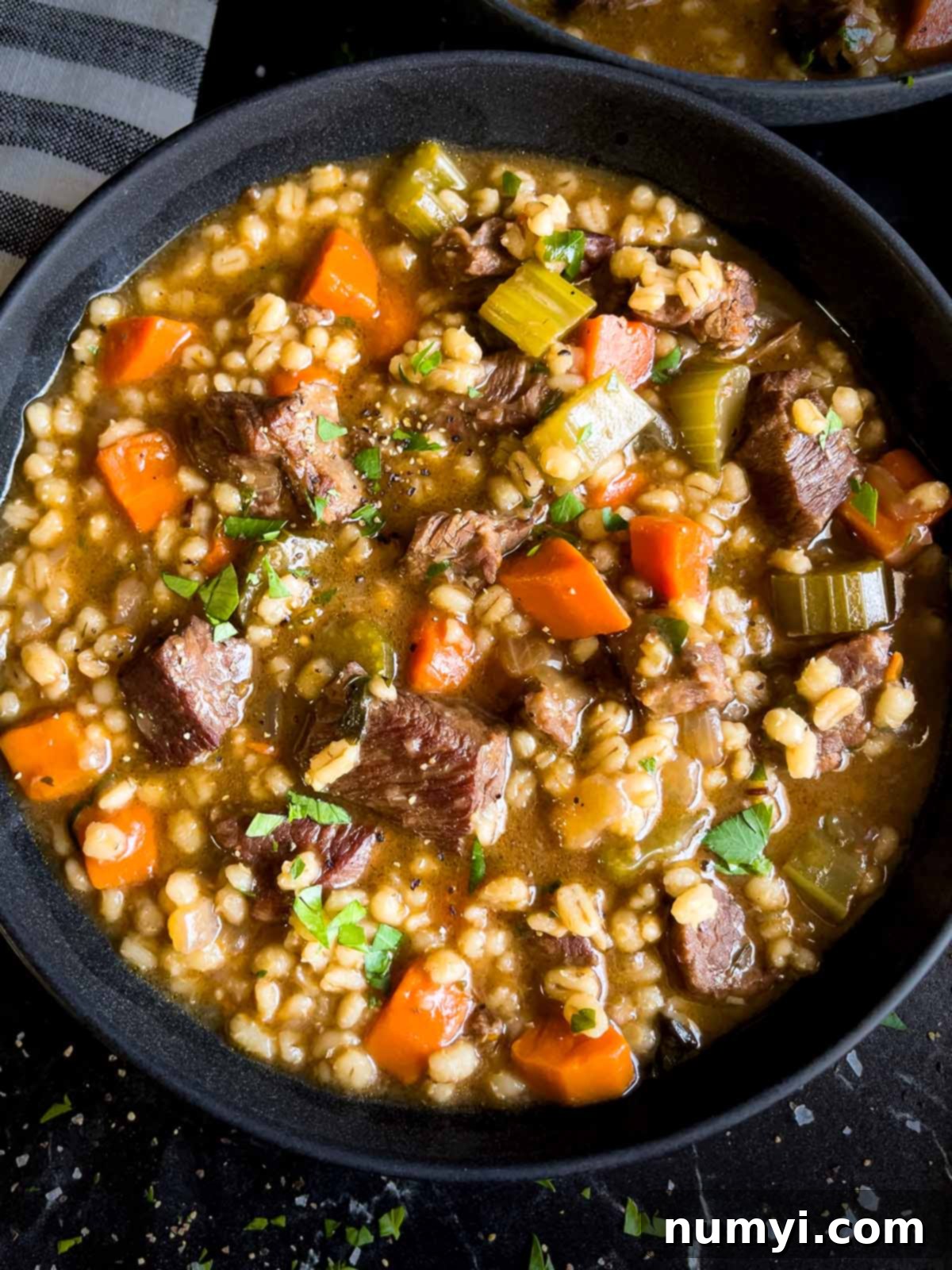Hearty & Satisfying Beef Barley Soup: The Ultimate Comfort Food Recipe
Nothing quite warms the soul and fills the stomach like a truly classic beef barley soup. This isn’t just any ordinary soup; it’s a rich, deeply flavorful meal packed with succulent, tender chunks of beef, perfectly cooked and plump pearl barley, and an abundance of fresh, healthy root vegetables. Each spoonful offers a delightful medley of textures and tastes, making it the quintessential comfort food for chilly evenings, crisp autumn days, or any time you crave a truly satisfying and nourishing meal. Forget overly complicated recipes – our detailed guide ensures you can recreate this beloved hearty soup right in your own kitchen with incredible ease.
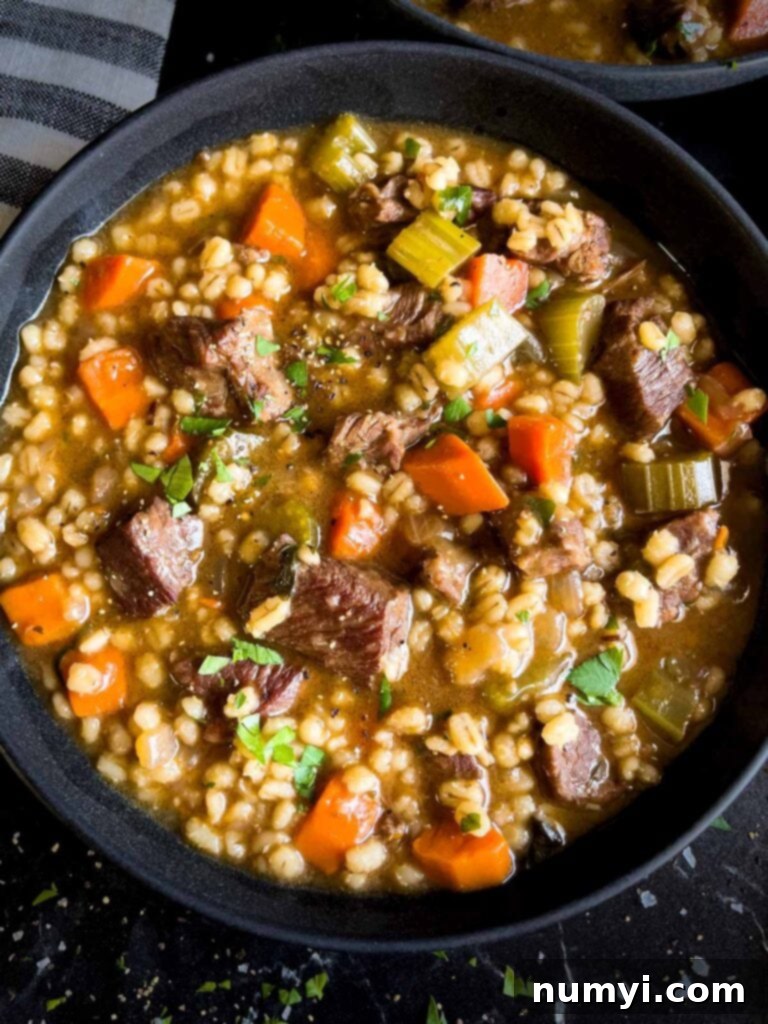
Why This Beef Barley Soup Recipe Will Become Your Favorite
There are countless reasons why this hearty beef barley soup stands out as a true culinary gem and a perennial favorite in many households. It’s more than just a meal; it’s an experience of warmth, flavor, and pure comfort. Here’s why you’ll absolutely adore this recipe:
- Unforgettable Beef Flavor: The secret to an outstanding beef barley soup lies in developing a rich, deep beef flavor from the very start. Our recipe focuses on essential techniques like browning the beef to create an unparalleled taste foundation that permeates every spoonful. This isn’t just beef broth; it’s a slow-simmered symphony of savory goodness, ensuring every bite is bursting with robust, comforting flavor.
- Packed with Nutritious Vegetables: Beyond the star ingredients, this soup is brimming with a colorful assortment of wholesome vegetables. Carrots, celery, and onions, often referred to as a mirepoix, not only add essential vitamins and minerals but also contribute significantly to the soup’s robust flavor profile and delightful texture. It’s a fantastic, delicious, and easy way to get your daily dose of veggies, making it a truly balanced meal.
- Budget-Friendly & Accessible: Despite its gourmet taste and satisfying richness, this beef barley soup is surprisingly economical to prepare. Utilizing cuts like beef chuck roast or pre-cut stew meat, which become incredibly tender with slow cooking, makes it a cost-effective choice for feeding a family or for convenient batch cooking. Most ingredients are readily available at any local grocery store, making it an accessible recipe for cooks of all skill levels.
- A Complete One-Pot Meal: Say goodbye to juggling multiple dishes and the ensuing mountain of cleanup! This beef and barley soup is thoughtfully designed as a complete meal in one pot. The beef, barley, and vegetables all cook together, allowing their distinct flavors to meld beautifully and eliminating the need for extra pots and pans. It’s perfect for busy weeknights or lazy weekends when you want maximum flavor with minimal fuss and easy cleanup.
- Deeply Satisfying Comfort Food: When you crave a meal that truly nourishes both body and soul, this soup delivers every single time. Its thick, rich consistency and layers of savory, umami-packed flavor make it incredibly satisfying and hearty. It’s the ultimate comfort food, providing warmth, contentment, and a feeling of nostalgic bliss with every single bite, reminiscent of cherished homemade meals.
- Excellent for Meal Prep & Freezing: Planning ahead for healthy and delicious meals has never been easier. This beef barley soup is ideal for making in advance, as its complex flavors only deepen and improve overnight. It also freezes exceptionally well, allowing you to prepare large batches and have delicious, homemade meals ready for those hectic days when cooking isn’t an option. It’s perfect for convenient future enjoyment throughout the colder months.
If you’re a fan of comforting and hearty soups that truly stick to your ribs, be sure to explore some of our other cherished soup recipes. We highly recommend our thick and hearty homestyle chili for another robust option, the wonderfully rich creamy beef stew for a velvety texture, the unique and flavorful shrimp and sausage gumbo, our delightful creamy bean soup with smoked sausage, and the wholesome goodness of our root vegetable soup.
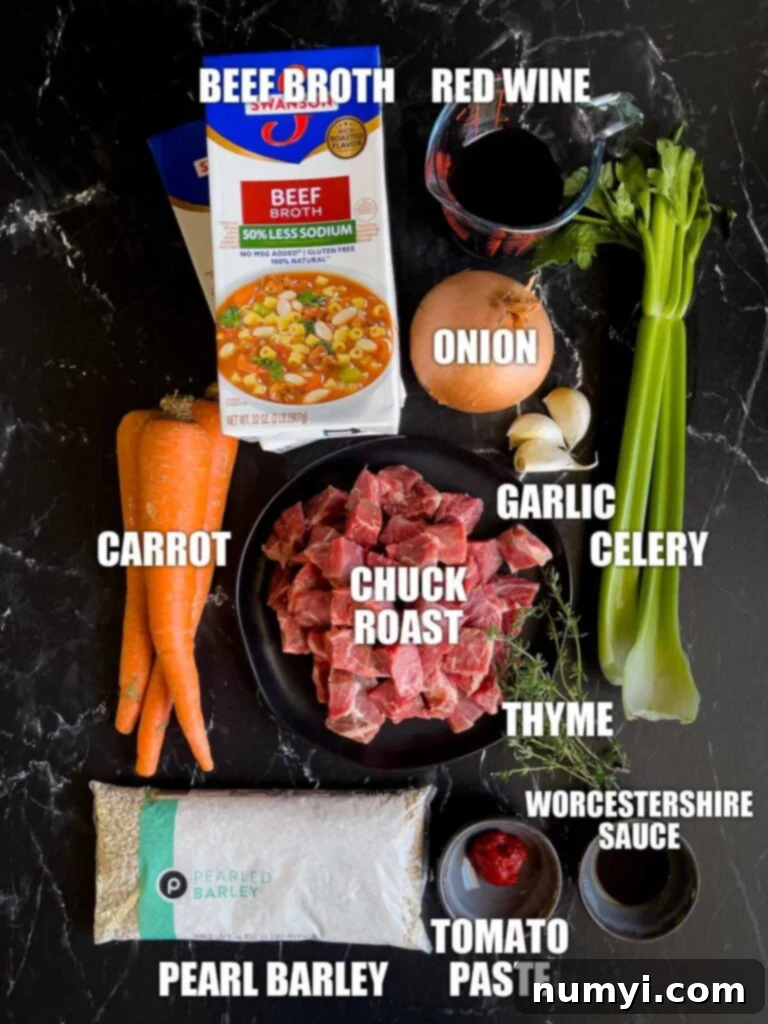
Essential Ingredients for a Perfect Beef Barley Soup
Crafting a truly exceptional beef barley soup starts with selecting the right, high-quality ingredients. Each component plays a vital role in building the deep, complex layers of flavor that make this dish so beloved and satisfying. Here’s a closer look at the key players you’ll need to create this comforting masterpiece:
- Beef (Boneless Chuck Roast or Stew Meat): For the most tender and flavorful beef barley soup, a boneless beef chuck roast is highly recommended. This cut, though initially tough, becomes incredibly succulent and fork-tender when slow-simmered over time, infusing the entire broth with a deep, rich, beefy essence. Alternatively, pre-cut stewing beef (often conveniently labeled as stew meat) works perfectly well and saves you valuable prep time. Regardless of your choice, ensure the beef is cut into uniform 1-inch cubes for even cooking and consistent texture in every spoonful.
- Aromatic Vegetables (Carrots, Celery, Yellow Onion): These three classic vegetables form the cornerstone of the “mirepoix,” a foundational flavor base in French cooking that lends a sweet and savory depth to the soup. Dicing them into roughly 1/2-inch pieces is ideal, as they need to withstand the longer cooking time without turning into a mushy pulp. They contribute not only essential nutrients but also a pleasant texture and vibrant color, enhancing both the taste and visual appeal of the finished dish.
- Flavorful Seasonings:
- Fresh Garlic Cloves: Freshly minced garlic is absolutely non-negotiable for its pungent aroma and unparalleled depth of flavor. When sautéed, it caramelizes slightly, adding a subtle sweetness and an incredible savory note that is crucial to the soup’s profile.
- Fresh Thyme: Earthy, herbaceous, and slightly peppery, fresh thyme sprigs infuse the soup with an aromatic quality that perfectly complements the rich beef and hearty vegetables. While dried thyme can be used as a substitute, fresh offers a brighter, more vibrant, and complex flavor.
- Worcestershire Sauce: This complex fermented condiment is a true secret weapon for adding a profound umami depth and a subtle tanginess. It significantly enhances the overall savory profile of the soup without overpowering the natural flavors of the beef and vegetables.
- Tomato Paste: A concentrated burst of rich tomato flavor, tomato paste adds a subtle sweetness, essential acidity, and a beautiful richness to the broth. When sautéed briefly, it deepens in color and flavor, contributing significantly to the soup’s hearty and robust base.
- Kosher Salt & Freshly Ground Black Pepper: These fundamental seasonings are absolutely crucial for balancing and amplifying all the other incredible flavors in the soup. Using low-sodium broth (as recommended) gives you complete control over the final salt content, allowing you to season precisely to your personal taste preference throughout the cooking process. Freshly ground black pepper adds a pleasant and aromatic kick.
- Essential Liquids:
- Dry Red Wine: A dry red wine (such as Cabernet Sauvignon, Merlot, or Pinot Noir) is used to deglaze the pot. This process involves dissolving all the flavorful browned bits (known as “fond”) stuck to the bottom after searing the beef and sautéing the vegetables. This step is critically important for building a complex, rich, and deeply flavored broth. Don’t worry about the alcohol content; it cooks off, leaving behind only its delicious essence.
- Low-Sodium Beef Broth or Beef Stock: This serves as the primary liquid base for your soup, providing the savory foundation. Opting for low-sodium varieties is important for health reasons and also gives you complete control over the final salt content of your soup, allowing you to season it perfectly to your taste without the risk of it being overly salty from the start. Remember that different brands of broth vary significantly in their sodium levels, so tasting and adjusting your seasonings as you go is always key.
With these high-quality and carefully chosen ingredients at your disposal, you’re well on your way to preparing a beef barley soup that’s brimming with truly outstanding flavor and incredibly satisfying for the entire family.
Crafting Your Homemade Beef Barley Soup: A Detailed Guide
Making a flavorful and comforting beef barley soup is a rewarding process, and while the full, detailed instructions are provided in the recipe card below, let’s walk through the key stages to ensure your soup is absolutely perfect. This method emphasizes building deep layers of flavor from the very beginning, ensuring a truly robust and satisfying final dish.
1. The Essential Browning Step
First, you’ll want to grab a spacious Dutch oven or a sturdy, heavy-bottomed stock pot – these are ideal because their thick bottoms distribute heat evenly, preventing scorching. Heat two tablespoons of olive oil over medium-high heat until it shimmers, indicating it’s hot enough. Before adding your beef, make sure to pat the cubes thoroughly dry with paper towels. This seemingly small step is vital; dry beef sears beautifully, creating a rich, brown crust through the Maillard reaction, whereas wet beef tends to steam, resulting in less flavor. Season the dried beef generously with kosher salt and freshly ground black pepper on all sides.
Now, carefully add the seasoned beef cubes to the hot pot. It’s crucial not to overcrowd your pan; if necessary, work in batches to maintain high heat. Overcrowding lowers the pan’s temperature, causing the beef to steam instead of sear, which means less delicious flavor development. Brown the beef on all sides until it achieves a deep, appetizing crust. Once nicely browned, remove the beef to a clean plate and set it aside.
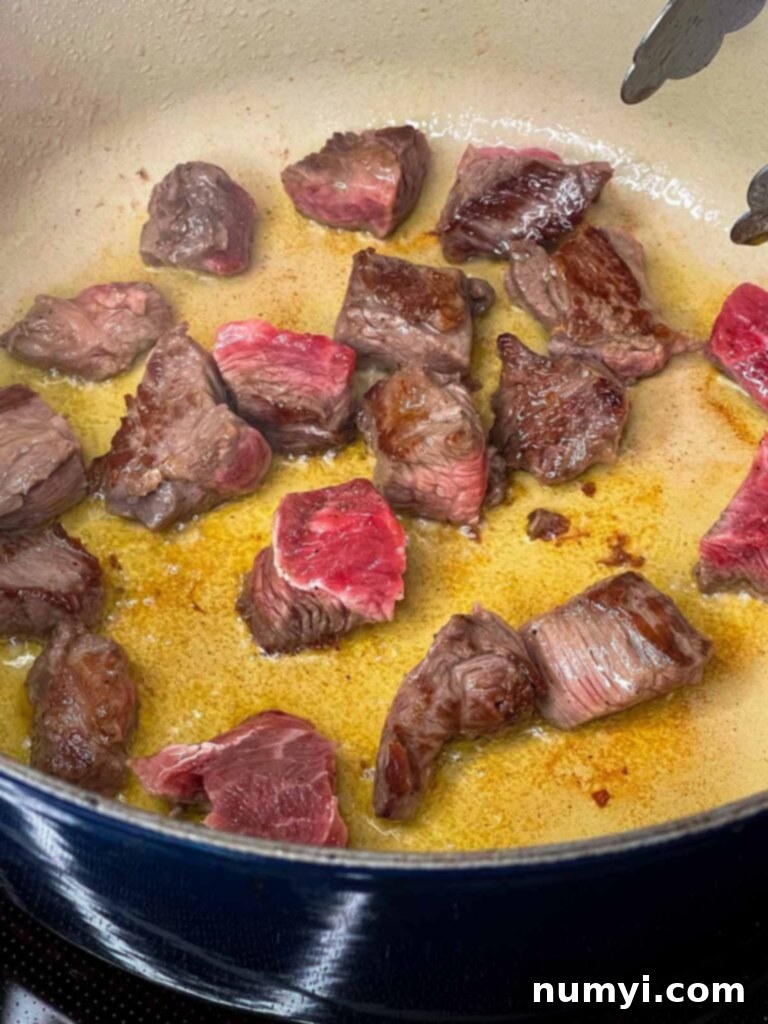
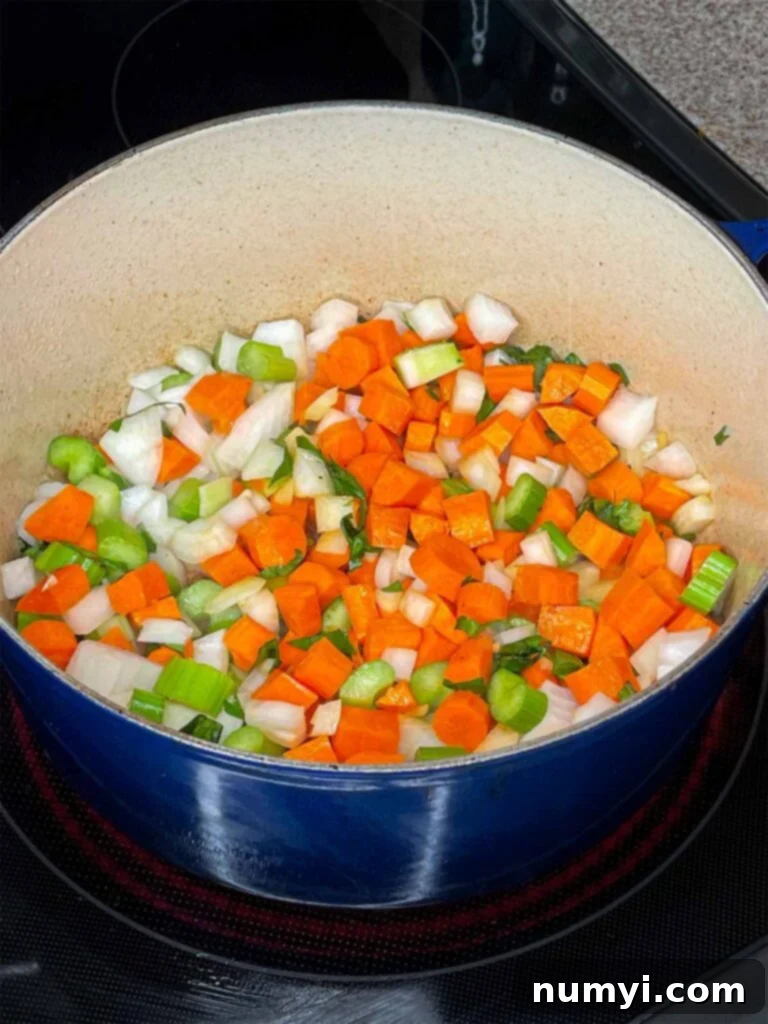
Chef’s Tip for Flavor
As emphasized, properly browning the beef is absolutely non-negotiable for achieving that coveted depth of flavor. This caramelization process adds layers of richness and savory notes that simply boiling the meat cannot provide. Another pro tip: if your celery ribs come with their leafy tops, do not chop them off and discard them! Instead, finely mince those leaves and add them to your pot along with the stalks during the sautéing process. Celery leaves are surprisingly aromatic and will impart a wonderful, fresh, herbaceous note that adds another dimension to your soup.
2. Building the Aromatic Base with Vegetables
With the browned beef set aside, add the remaining tablespoon of olive oil to the pot. It’s time to build the aromatic foundation of your soup. Add the diced carrots, celery, and onions, which collectively form the mirepoix. Sauté these essential vegetables for about 5 minutes, stirring occasionally, until they begin to soften and become slightly translucent. This step helps to sweeten the vegetables and release their essential flavors into the pot, contributing to the overall complexity of the broth.
Next, stir in the concentrated tomato paste and the freshly minced garlic. Continue to sauté for another 30 seconds to a minute, stirring constantly, until the garlic becomes wonderfully fragrant and the tomato paste deepens slightly in color. Be very careful not to burn the garlic, as it can quickly turn bitter and affect the flavor of your entire soup.
3. Deglazing for Enhanced Depth of Flavor
Now for the magic step that unlocks even more flavor: pour in the dry red wine. Bring the wine to a vigorous boil, letting it cook for about 2 minutes. As it boils, use a sturdy wooden spoon or spatula to vigorously scrape up all the delicious browned bits (the “fond”) that are stuck to the bottom of the pan. This crucial process, known as deglazing, dissolves those flavorful caramelizations into the liquid, adding immense depth, complexity, and a beautiful richness to your broth. Don’t worry about the alcohol content; it will cook off, leaving behind only the delicious essence of the wine.
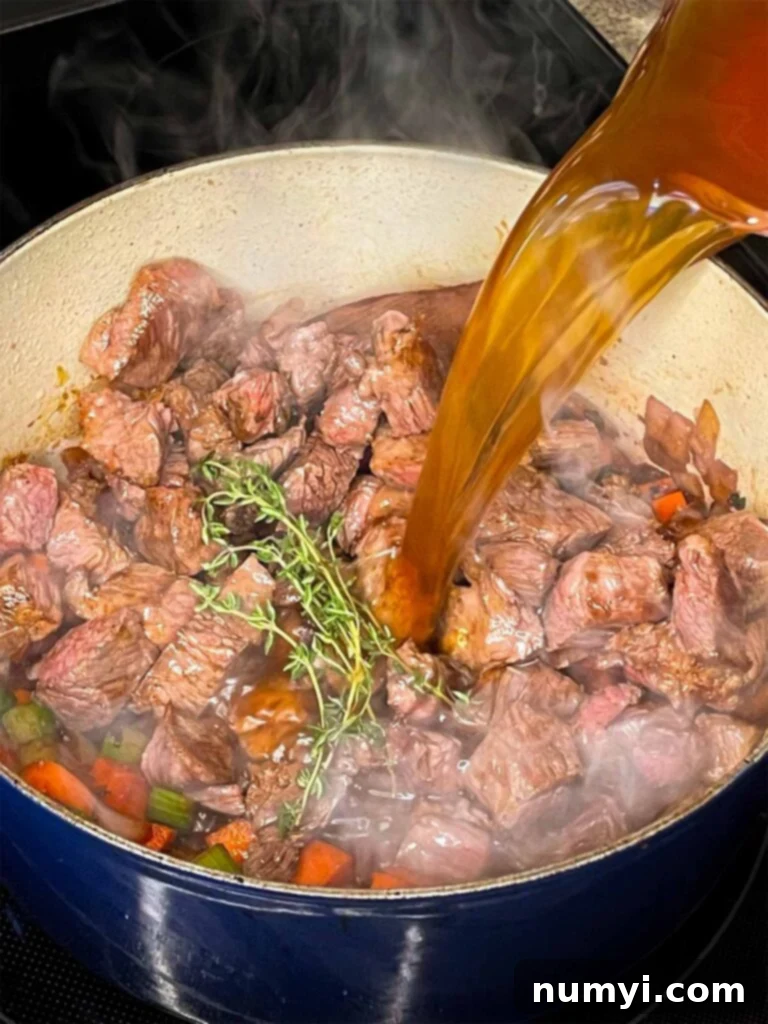
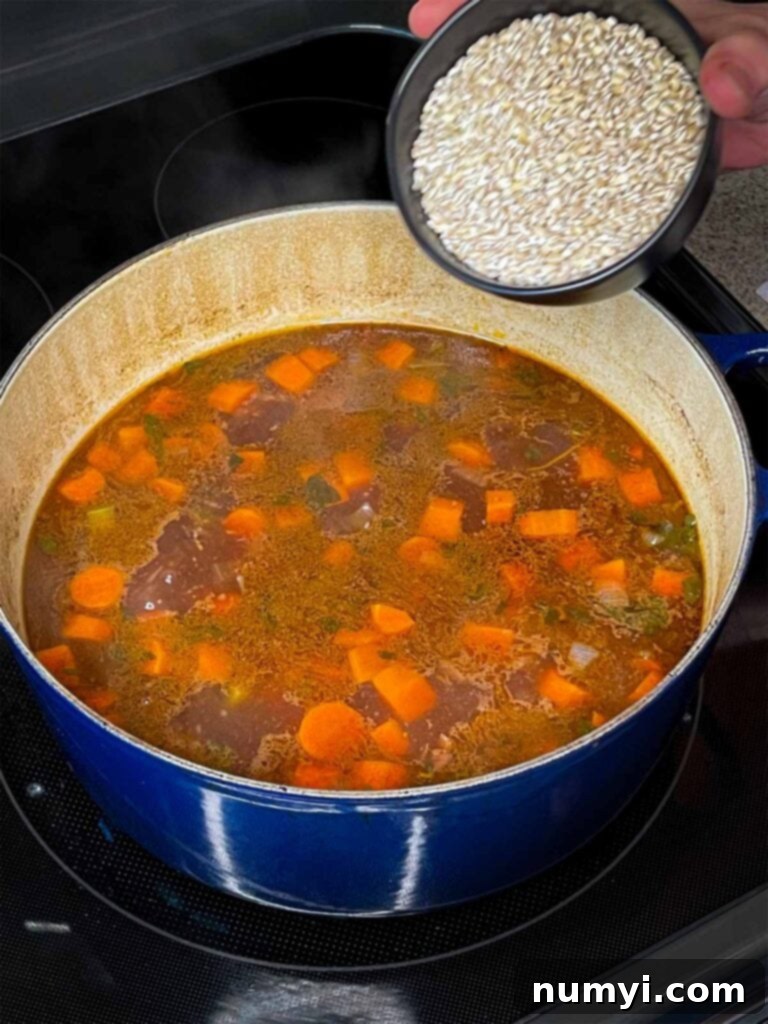
4. The Long Simmer: Tenderizing Beef and Infusing Flavors
Once the pot has been properly deglazed, return the browned beef to the pan. Add the fresh thyme sprigs (or dried thyme if using), a generous tablespoon of Worcestershire sauce, and the low-sodium beef broth. Bring the entire mixture to a boil, then immediately reduce the heat to a gentle simmer. Cover the pot tightly and let it cook for a robust 45 minutes, stirring occasionally to prevent anything from sticking to the bottom. At this initial stage, your beef will be tenderizing and softening, but it won’t yet be fall-apart soft; this first simmer allows the flavors to begin melding beautifully.
After the initial simmer, it’s time to introduce the pearl barley. Stir it into the soup, ensuring it’s fully submerged in the liquid. Cover the pot once more and continue to simmer for an additional 45-60 minutes. The exact cooking time will vary slightly depending on the type of barley and your desired texture, but you’re looking for barley that is tender yet retains a pleasant, slight chew to it. By this extended simmering stage, your beef should have reached that desirable “ultra tender” consistency, practically melting in your mouth, and the barley will have absorbed the rich flavors of the broth, swelling into plump, satisfying pearls.
5. Final Touches and Serving Your Hearty Soup
The final step is crucial for perfection: tasting and adjusting the seasoning. Carefully remove and discard the woody thyme stems from the soup. Taste the soup and adjust with additional kosher salt and freshly ground black pepper as needed. Remember, you started with low-sodium broth, so this is your opportunity to customize the saltiness and ensure the flavor profile is perfectly balanced for your palate. I typically start with about 1/2 teaspoon of each, but your personal preference may vary, so always taste and adjust incrementally. Finally, stir in the fresh minced parsley for a vibrant burst of fresh flavor and a beautiful touch of color. Ladle the hot and hearty beef barley soup into bowls and, for an extra-special presentation, garnish each serving with an additional sprinkle of minced fresh parsley. Serve hot and enjoy this incredibly comforting and satisfying meal!
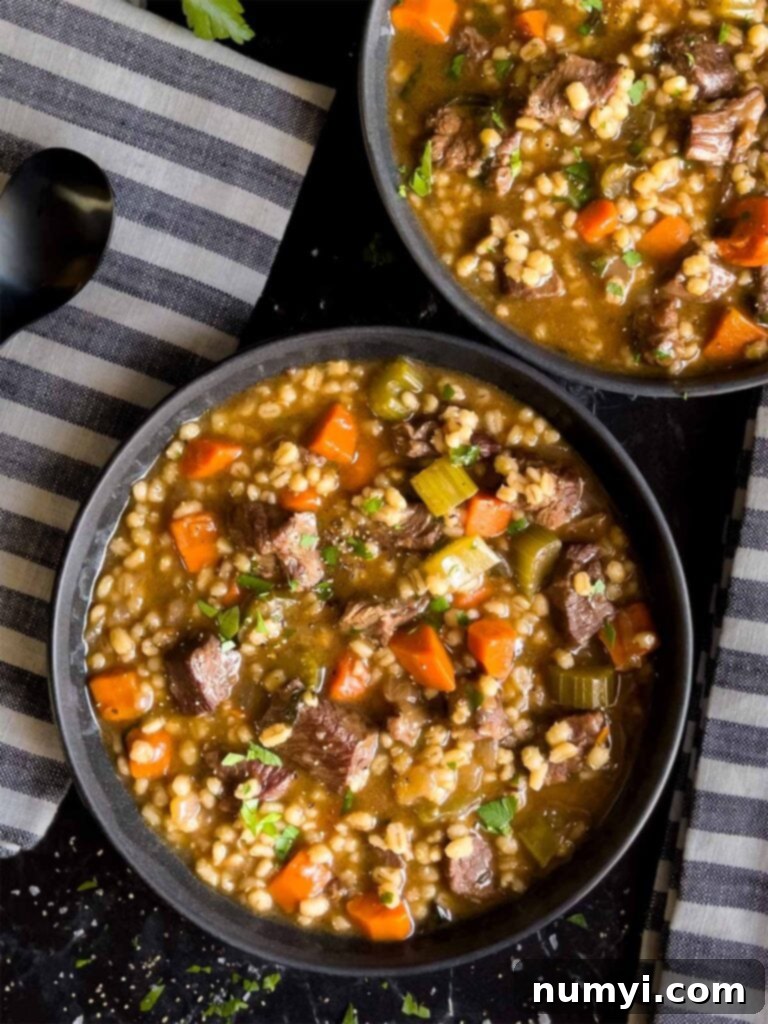
For an extra touch of freshness and visual appeal, garnish each bowl with a sprinkle of additional minced parsley before serving, highlighting the vibrant green against the rich, dark hue of the soup.
Perfect Pairings: What to Serve with Hearty Beef Barley Soup
While a generous bowl of this magnificent beef barley soup is undeniably a complete and satisfying meal all on its own, pairing it with certain complementary sides can elevate the dining experience even further. The right accompaniment can add textural contrast, a refreshing element, or simply more comforting goodness. Here are some fantastic options to serve alongside its rich flavors and hearty texture:
- Crusty Bread: A timeless and classic choice, a good piece of crusty bread is absolutely perfect for soaking up every last drop of the savory, thick broth. Consider serving it with homemade no-knead skillet bread for a rustic touch or some fluffy and flavorful cheddar chive biscuits. A warm baguette, a rustic artisan loaf, or even a slice of sourdough would also be excellent choices. The delightful contrast between the soft interior and crispy crust adds a wonderful textural element to your meal.
- Simple Green Salad: To add a refreshing counterpoint and balance the richness of the soup, a light and vibrant green salad is an ideal accompaniment. Opt for crisp mixed greens, such as spring mix or romaine, tossed with a tangy vinaigrette. The bright acidity of the dressing will beautifully cut through the soup’s richness, cleansing the palate and adding a fresh, zesty note that makes each spoonful of soup even more enjoyable.
- Roasted Vegetables: For an extra dose of healthy goodness and another layer of flavor, consider serving a side of simply roasted seasonal vegetables. Asparagus, tender-crisp green beans, broccoli florets, or Brussels sprouts roasted with a touch of olive oil, salt, and pepper can add another layer of texture and vital nutrients. Their slightly caramelized, earthy flavors can beautifully complement the robust and savory notes of the beef barley soup.
- Garlic Bread or Cheesy Toast: Take your bread pairing up a notch with warm, buttery garlic bread or gooey, melted cheese toast. The aromatic garlic and rich, melted cheese provide an irresistible indulgence that pairs wonderfully with the robust and deeply flavored soup, creating a truly satisfying combination.
- Warm Cornbread: A warm slice of cornbread, whether you prefer it slightly sweet or savory, can be a delightful addition to this meal. It offers a different kind of texture and a touch of wholesome, comforting Southern charm that harmonizes exceptionally well with the beef and barley flavors.
No matter which side dish you choose, these thoughtful pairings will undoubtedly enhance your beef barley soup experience, transforming a comforting meal into a truly memorable and wholesome feast for you and your loved ones.
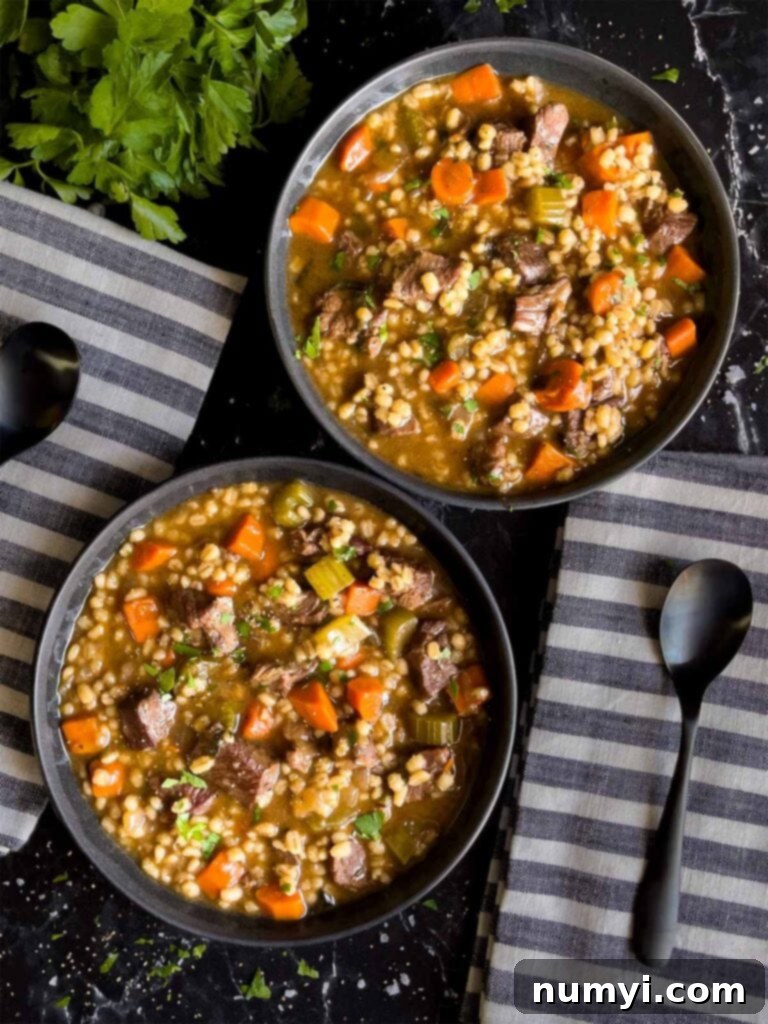
Expert Tips for the Best Beef Barley Soup
Achieving a restaurant-quality, deeply flavorful beef barley soup at home is much easier than you might think, especially when you keep these expert insider tips in mind. They’ll help you maximize flavor and ensure perfect texture every time:
- Customize Your Beef Cut: While pre-cut stew meat offers convenience, consider purchasing a boneless chuck roast and dicing it into 1-inch cubes yourself. This is often my preferred method because it allows you to control the size and consistency of the meat, ensuring uniform cooking and a superior, melt-in-your-mouth texture in your finished soup. Additionally, freshly cut beef can often achieve a better, more flavorful sear during the browning process.
- Uniform Vegetable Dicing is Crucial: For the carrots, celery, and onions (your classic mirepoix), aim for uniformly sized 1/2-inch chunks. This consistent sizing is important because this vegetable beef barley soup simmers for an extended period. Larger, uniformly cut vegetables will retain their structure and texture, becoming perfectly tender without disintegrating into a mushy pulp. Consistent dicing also ensures they cook evenly and contribute perfectly to the soup’s overall mouthfeel and appearance.
- Absolutely Avoid Quick-Cooking Barley: This recipe specifically calls for pearl barley, and it’s essential not to substitute it with quick-cooking barley. The long, slow simmering time is absolutely critical for the beef to break down and become incredibly tender and flavorful. Quick-cooking barley, which cooks in a mere 10-12 minutes, would turn into an unappetizing mush long before the beef reaches its optimal tenderness. Stick with pearl barley for the best texture and to allow it ample time to absorb the rich, complex flavors of the broth.
- Adjust Soup Consistency to Your Liking: This beef barley soup is intentionally designed to be robust and thick, often leaning almost towards a hearty stew-like consistency. If you prefer a thinner soup, you can easily adjust it by adding more low-sodium beef broth until you reach your desired consistency. It’s crucial to use additional broth rather than water, as plain water would dilute the rich, savory flavor you’ve meticulously built through browning and simmering. Always taste and adjust seasonings if you add more liquid.
- Don’t Rush the Browning Process: As highlighted in the cooking instructions, properly browning the beef is paramount for exceptional flavor. It’s not just about creating a nice color; it’s about developing deep, complex, and savory flavors through the Maillard reaction. Take your time with this step, ensure you don’t overcrowd the pot, and aim for a beautiful, caramelized crust on each piece of beef. This initial effort pays immense dividends in the final, delicious taste of your soup.
- Taste and Adjust Seasoning Throughout: Because different brands of beef broth and other ingredients can vary significantly in their sodium content, it’s vital to taste your soup at various stages of cooking, especially after the long simmer and when adding any more liquid. Season with salt and pepper incrementally until the flavor profile is perfectly balanced and pleasing to your palate.
- Consider Using Fresh Herbs: While fresh thyme is specified and works wonderfully, don’t hesitate to experiment with other fresh herbs for an added layer of aromatic complexity. A sprig or two of fresh rosemary can add a piney, robust flavor that pairs exceptionally well with beef. Adding one or two bay leaves to the simmering broth will also contribute a subtle, savory, and herbaceous note (just remember to remove them before serving, as they are not meant to be eaten!).
By keeping these practical and expert tips in mind, you’ll be well on your way to mastering this classic beef barley soup recipe and impressing everyone who has the pleasure of tasting your incredibly flavorful creation.
Exciting Variations to Customize Your Beef Barley Soup
One of the true joys of home cooking is the ability to adapt recipes to suit your personal taste preferences, utilize ingredients you have readily on hand, or simply try something new for a fresh twist. This beef barley soup recipe is wonderfully versatile, offering plenty of room for creative variations that can make it uniquely yours:
- Add Potatoes for Extra Heartiness: For an even more substantial and filling soup, consider adding potatoes to the mix. When doing so, always opt for waxy varieties like Yukon Gold, small red potatoes, or new potatoes. These types hold their shape beautifully and maintain a pleasant texture during extended cooking. Avoid starchy Russet potatoes, as they tend to absorb too much liquid and break down, which can make the soup overly starchy and cloudy. Add them along with the barley for a similar cooking time.
- Incorporate Earthy Mushrooms: Mushrooms are a fantastic addition to beef barley soup, contributing an earthy, umami depth that complements the beef perfectly. Sauté sliced Baby Bella (cremini) mushrooms along with the carrots, celery, and onions. White button mushrooms also work very well. They absorb the rich broth and provide a delightful, meaty texture contrast that enhances the overall experience of the soup.
- Experiment with Different Fresh Herbs: While fresh thyme is a classic and reliable choice, don’t hesitate to explore other aromatic herbs for a slightly different flavor profile. A sprig of fresh rosemary can add a distinct piney, robust flavor that pairs wonderfully with beef. Adding one or two bay leaves to the simmering broth will also contribute a subtle, herbaceous note and a deeper aroma (just remember to remove them before serving, as they are not meant to be consumed).
- Red Wine Alternatives: If you prefer not to use red wine in your cooking, or simply don’t have any on hand, you can easily substitute it without losing much flavor. Replace the 1/2 cup of red wine with an equal amount of low-sodium beef broth. You might also consider adding a small splash of balsamic vinegar or apple cider vinegar (about 1-2 tablespoons) along with the broth to provide a touch of the acidity that the wine would otherwise contribute, which helps to deglaze the pan and brighten the overall flavors of the soup.
- Spice It Up for a Kick: For those who enjoy a little bit of heat in their comfort food, a pinch of red pepper flakes added with the garlic and tomato paste can give the soup a subtle, warming kick. A dash of smoked paprika could also add a lovely depth and a smoky aroma that pairs excellently with the beef.
- Add More Root Vegetables: Beyond the traditional carrots, celery, and onions, feel free to toss in other hearty root vegetables like parsnips, turnips, or rutabaga. Cut them into similar 1/2-inch pieces so they cook evenly. They will add more nutritional value, different textures, and a slightly unique sweet, earthy flavor dimension to your beef barley soup.
- Make it a Leftover Roast Revival: If you happen to have any leftover cooked roast beef, you can significantly reduce the cooking time and create an equally delicious soup! In this scenario, you would skip the initial browning of raw beef. Instead, proceed by sautéing the vegetables and deglazing the pot, then add the broth, seasonings, and the pre-cooked beef (shredded or cut into cubes) along with the barley. Simmer until the barley is tender and the beef is heated through and thoroughly infused with the soup’s flavors.
These exciting variations offer fantastic and easy ways to personalize your beef barley soup, allowing you to create a dish that perfectly matches your preferences, available ingredients, and culinary adventurousness.
Frequently Asked Questions About Beef Barley Soup
To help you master this comforting and incredibly satisfying dish, here are some common questions and detailed answers regarding beef barley soup, covering everything from ingredients to preparation and storage:
Barley is a highly nutritious cereal grain, well-regarded for its slightly chewy texture and mild, distinctly nutty flavor. It’s similar in size and consistency to brown rice but possesses its own unique character. In this recipe, we specifically use pearl barley, which is barley that has had its inedible outer husk and much of its bran layer removed (a process known as “pearling”). This makes it more tender and quicker to cook than hulled barley, and it’s also widely available in most grocery stores. It’s an excellent addition to soup because it naturally thickens the broth as it cooks, adds a wonderful substance, and provides a satisfying, hearty mouthfeel, transforming the soup into a truly robust and filling meal.
While it might seem like a convenient shortcut, we strongly advise against using quick-cooking barley in this particular beef barley soup recipe. The beef requires a long, slow simmering period—typically 1.5 to 2 hours—to achieve the desired fork-tender, melt-in-your-mouth texture. Quick-cooking barley, on the other hand, is processed to cook in a mere 10-12 minutes. If you add it at the beginning of the cooking process, it will turn into an unappetizing mush long before the beef has had a chance to become tender. If quick-cooking barley is absolutely all you have available, you should cook the soup base (beef, vegetables, and broth) for at least 1 1/2 hours until the beef is nearly tender, and then stir in the quick-cooking barley for just the last 10-12 minutes of cooking. This way, both components will be perfectly cooked.
For the most tender, flavorful, and truly robust beef barley soup, a boneless beef chuck roast is the top recommendation. Chuck roast is a relatively inexpensive cut of beef that comes from the shoulder, and it’s rich in connective tissue. This tissue breaks down beautifully during long, slow cooking, resulting in incredibly tender, succulent beef that practically melts in your mouth and imparts a deep, rich, beefy flavor to the broth. Pre-cut “stew meat” is also an excellent and convenient option, as it’s typically cut from chuck or a similar cut that benefits immensely from extended simmering. These cuts are tough initially but transform into a luxurious texture with proper, patient cooking.
Yes, you absolutely can use ground beef for a quicker and equally delicious beef barley soup, although the texture will naturally be different (less “chunky” and more uniformly meaty). If using ground beef, start by browning about 1.5-2 pounds of lean ground beef in your pot, breaking it up as it cooks. Drain any excess fat thoroughly, then remove the browned ground beef to a plate and set aside. Continue with the recipe as directed by sautéing the mirepoix vegetables and deglazing the pot. Once the broth is added along with the seasonings, return the browned ground beef to the pot, cover, and simmer for about 30 minutes to allow the flavors to meld effectively. Then, add the barley and simmer for the standard 45-60 minutes until the barley is tender. This method also works wonderfully if you have leftover cooked roast beef; simply shred or cube it and add it with the barley to heat through and infuse with the soup’s flavors.
Absolutely! Beef barley soup is an excellent candidate for meal prepping and tastes even better the next day. In fact, its complex flavors often deepen and improve overnight, making it even more delicious after a day in the refrigerator. To make it ahead, we recommend cooking the soup completely, but consider adding the barley only when you are ready to serve it. If you cook the barley in advance and store it with the soup, it tends to absorb a lot of the broth and can become very soft, changing the texture significantly. For the best results, prepare the soup base (beef, vegetables, and broth) up to 3 days in advance, allow it to cool completely to room temperature, and then store it in an airtight container in the refrigerator. When you’re ready to eat, bring the soup base to a gentle boil, then add the pearl barley, cover, and simmer for 45-60 minutes until the barley is perfectly tender. This ensures perfectly textured barley and a rich, robust broth.
Yes, a slow cooker is a fantastic way to prepare beef barley soup, allowing you to achieve a tender, flavorful meal with minimal active effort. To adapt this recipe for a slow cooker: first, brown the beef cubes thoroughly in a skillet on the stovetop (this step is crucial for developing deep flavor, so don’t skip it!). Transfer the browned beef to your slow cooker pot. Next, in the same skillet, sauté the carrots, celery, and onions for about 5 minutes, then add the minced garlic and tomato paste for another minute until fragrant. Deglaze the pan with the red wine (or extra broth if omitting wine), scraping up all the delicious browned bits, and pour this flavorful liquid into the slow cooker. Add the beef broth, Worcestershire sauce, and thyme to the slow cooker along with the pearl barley. Cook on low for 7 to 8 hours, or on high for 3-4 hours, until the beef is incredibly tender and the barley is cooked through. For ultimate morning convenience, you can do the browning of the meat and dicing of vegetables the night before, refrigerating them separately, and then simply assemble everything in the slow cooker in the morning.
Proper storage ensures your delicious beef barley soup remains fresh, safe, and enjoyable for days. Allow the soup to cool completely to room temperature before transferring it to an airtight container. Refrigerate promptly for up to 4 days. When reheating, you might notice that the barley has absorbed a significant amount of the broth, making the soup much thicker and sometimes porridge-like. This is perfectly normal. Simply add a splash more low-sodium beef broth or even a little water (if you don’t mind a slight dilution of flavor) to reach your desired consistency while gently reheating on the stovetop over low heat or in the microwave. Stir occasionally to ensure even heating.
Yes, beef barley soup freezes exceptionally well, making it a perfect candidate for convenient batch cooking and future wholesome meals. Once the soup has completely cooled to room temperature, transfer it into freezer-safe containers or heavy-duty freezer bags. Be sure to leave about an inch of headspace if using containers to account for liquid expansion during freezing. Freeze the soup for up to 3 months for optimal freshness. To reheat, thaw the frozen soup overnight in the refrigerator. Then, transfer it to a pot and gently reheat on the stovetop over medium-low heat, stirring occasionally, until thoroughly warmed through. Just like with refrigerated leftovers, the barley will likely have absorbed much of the liquid, so you may need to add additional beef broth or water to achieve your preferred consistency. Enjoying homemade soup from the freezer is a wonderful and healthy convenience!
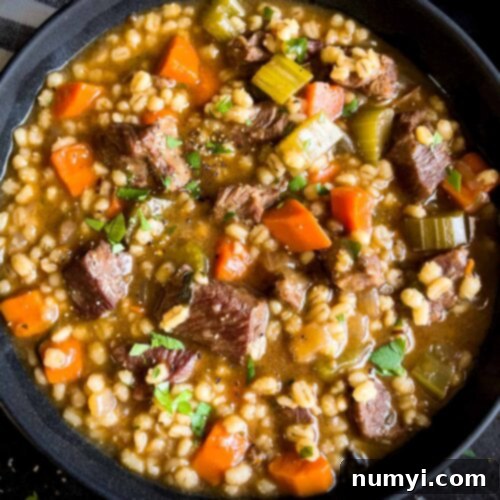
Beef Barley Soup Recipe
Print
Pin
Rate
Ingredients
- 3 tbsp Olive oil divided
- 2 lbs Chuck roast cut into 1-inch cubes
- 3 medium Carrots diced into 1/2-inch pieces
- 2 large Celery ribs diced into 1/2-inch pieces
- 1 medium Onion diced
- 1 tbsp Tomato paste
- 4 cloves Garlic minced
- 1/2 cup Red wine
- 1 tbsp Worcestershire sauce
- 6 cups Low-sodium beef broth
- 4 sprigs Fresh thyme or 1/2 tsp dried thyme
- 3/4 cup Pearl barley
- 1/2 tsp Kosher salt more or less to taste
- 1/2 tsp Black pepper more or less to taste
- 1/4 cup Fresh parsley minced
Instructions
-
Heat a large dutch oven or heavy-bottomed stock pot over medium-high heat, and add 2 tablespoons of olive oil. Pat the beef cubes dry with paper towels. Season them with salt and pepper.3 tbsp Olive oil
-
Brown the beef on all sides. Do this in batches, don’t overcrowd the pan. Remove the meat to a plate, and set aside.2 lbs Chuck roast
-
Add the remaining tablespoon of olive oil. Add the carrots, celery, and onions and saute for about 5 minutes, add the tomato paste and minced garlic. Saute for about 30 seconds until fragrant.3 medium Carrots, 2 large Celery ribs, 1 medium Onion, 1 tbsp Tomato paste, 4 cloves Garlic
-
Add the red wine, and boil for about 2 minutes while scraping the brown bits up from the bottom of the pan.1/2 cup Red wine
-
Add the browned beef back to the pan with the thyme, Worcestershire sauce, and beef broth. Bring to a boil, reduce the heat to a simmer, cover, and simmer for 45 minutes stirring occasionally. The beef cubes will not be fall apart tender at this point.1 tbsp Worcestershire sauce, 4 sprigs Fresh thyme, 6 cups Low-sodium beef broth
-
Add the barley, cover, and simmer for 45-60 minutes until the barley is tender stirring occasionally. Barley is done when it is tender, yet slightly chewy. This is when the beef should be ultra tender!3/4 cup Pearl barley
-
Season to taste with salt and pepper. Stir in the fresh parsley and remove the thyme stems.1/2 tsp Kosher salt, 1/2 tsp Black pepper, 1/4 cup Fresh parsley
Notes
If you don’t want to use red wine replace it with 1/2 cup of beef broth.
Make Ahead – See FAQ section.
Storing – Let the soup cool, place it in an airtight container, and refrigerate for up to 4 days. When reheating you may need to add more beef broth or water. The barley tends to soak up most of the broth.
Freezing – Let the soup cool, place it in a freezer-safe airtight container, and freeze it for up to 3 months. Thaw in the refrigerator overnight, and reheat using your desired method. You may need to add more broth or water.
